August 14, 2020
A rose is a rose is a rose is a rose is a cauliflower. That’s not quite the right quote from Gertrude Stein, but it’s the line that keeps going through my head after my recent encounter with a bright pink coral head. After I explained to my novice snorkeling companion that this stunning bouquet of creatures is called a rose coral, I later looked it up, and found that my books call it cauliflower coral.
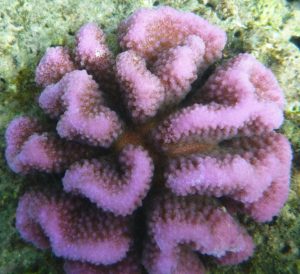
A rose/cauliflower coral ©Susan Scott
Depending on the color of the symbiotic algae that live in this free-standing coral species (Pocillopora meandrina), it can be a variety of colors. Most are brown or cream, and a few are pink. But regardless of color, all colonies have the clumped look of a head of cauliflower, making that name most fitting.
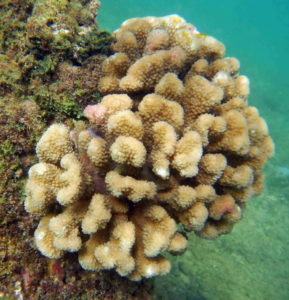
Perched sideways to the waves. ©Susan Scott
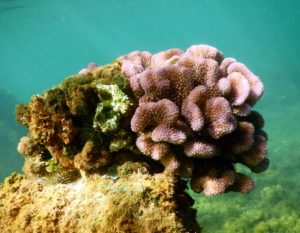
This cauliflower coral head suffers damage on the left, but thrives on the right.©Susan Scott
But, oh, those lovely pink ones do stand out, and have made their mark. An Internet search of the words “rose coral” comes up roses – real roses. Called coral reef roses, the flowers range from peach to hot pink, a fitting tribute to the cauliflower/rose coral species.
What does not stand out in cauliflower coral heads, but is well worth a look, are the crabs and fish that hide inside the colony’s branches.
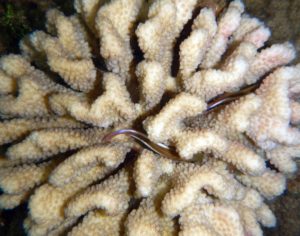
Two arc-eye hawkfish shelter in this cauliflower coral head. ©Susan Scott
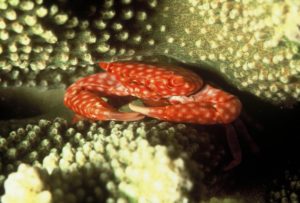
A yellow-spotted coral guard crab. With their sharp claws, these crabs poke intruders, therefore, protecting their coral home. Photo courtesy of David Schrichte.
My peek into a cauliflower coral last week was another occasion of my camera finding something I missed. (Thanks again, little camera.) While I concentrated on taking a picture of a speckled scorpionfish sheltering in the arms of a cauliflower coral, my camera caught its companion below. I only noticed the second fish in the downloaded photo.
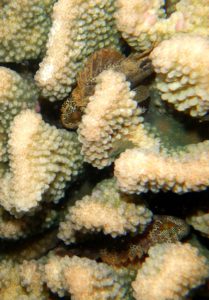
My two speckled scorpionfish. The top one is mine, the lower one my camera’s. ©Susan Scott
Cauliflower coral colonies stand like sturdy bushes on reefs with strong waves and currents. I often see these coral heads in only a few feet of water, but the species thrives to 100 feet deep. Unlike most other hard corals, cauliflower corals have a maximum size of 12-to-18 inches across, giving them stability in rough water. Some colonies perch on the tops and corners of rocks, while others stand their ground on the hard ocean floor.
Cauliflower coral heads ranges throughout the Pacific and Indian Oceans, and is one of Hawaii’s most common coral species. Besides offering shelter to small reef animals, cauliflower coral heads were also useful to ancient Hawaiians, who used the rough-surfaced branches as sandpaper.
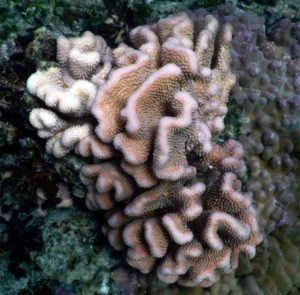
Some bleaching is occurring on the the left side of this coral head, which is either a cauliflower coral or antler coral. The two are close relatives. Whichever species it is, I took this picture to monitor its recovery, or not, this winter when the water is cooler. ©Susan Scott
Gertrude Stein’s famous line of poetry, “A rose is a rose is a rose” means to me, “It is what it is.” During this time of disease and political discord, this seems a worthwhile mantra to be stuck in my head. It helps me get in the water, where, in a cauliflower coral head, I find great joy.
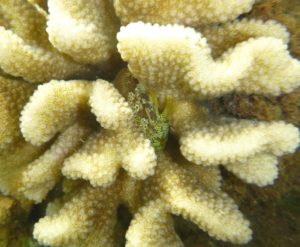
An unknown (to me) fish, with two raised “horns,” sheltering in a cauliflower coral. The photo is fuzzy, but gives me a species to look for again. ©Susan Scott
P.S. To answer some readers’ questions: After years of trying different cameras and programs, I’ve settled happily on a Nikon COOLPIX W300, and photo editing program, ACDSee. The little camera tucks easily in my swim suit, and the user-friendly program brings out the best in my pictures.

One of my best snorkeling buddies. It’s sturdy leash for my neck, made for me by Craig, keeps it close.